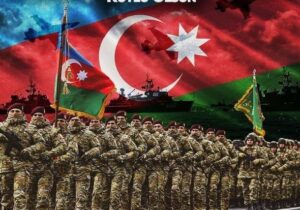
By Akbar Novruz
A meeting in the EU-USA-Armenia format convened in Brussels, and as anticipated by the Azerbaijani government, it emerged as a significant setback to peace in the South Caucasus from its onset.
On April 5, between 15:10 and 17:35, Armenian armed forces initiated fire on Azerbaijani Army positions situated towards various residential areas in the Tovuz region. Essentially, revanchist separatists laid the groundwork for their forthcoming provocations even before the conclusion of the EU-USA-Armenia meeting in Brussels, validating the Azerbaijani government’s assertion regarding the meeting’s adverse impact on regional peace. Despite exhibiting consistent provocative behavior, Armenian armed units persisted in their tradition and resumed firing on Azerbaijani positions later that evening, from 21:55 to 23:20.
According to the Azerbaijani Ministry of Defense, Azerbaijani Army units were targeted 30 times over the past day across different sectors.
Interestingly, on April 1, the famous “Washington Times” published a commentary predicting the orchestrated nature of ongoing developments. The headline, ‘ Biden’s State Department should heed Ragan’s’ peace through strength’ message,” set the tone for an analysis. That article begins with an introduction that many may not be able to describe at first sight: Armenia must be removed from Russia’s satellite. 
Robert Livingston, the author of the piece, has a notable history, having worked closely with former US President Ronald Reagan in the 1980s and serving as a House Intelligence and Appropriations Committee member. Livingston is registered under the Foreign Agents Registration Act to represent the National Democratic Alliance in the United States with the Livingston Group and has been a member of the Louisiana Congress for 22 years.
Livingston’s article lays out a narrative asserting that recent events are part of a larger strategic plan. He argues that the conflict in Ukraine, which escalated into the Russia-Ukraine war in 2022, led to the US ignoring Russia’s annexation of Crimea in 2014, consequently allowing Moscow to regain strength. He draws parallels, suggesting that Armenia is following a similar trajectory.
The article continues by highlighting “Armenia’s precarious geopolitical position, bordered by historical rival Türkiye and Azerbaijan engaged in conflict over the disputed Nagorno-Karabakh region (Artsakh in Armenian).” Livingston criticizes Russia for failing to fulfill its security obligations to Armenia, leaving Yerevan vulnerable and resulting in the displacement of 120,000 Armenians.
The narrative presented in the article, however, diverges from internationally recognized facts, notably referring to the Karabakh territory of Azerbaijan as “Artsakh” and alleging baseless claims of ethnic cleansing. The President of the Republic of Azerbaijan Ilham Aliyev and the Azerbaijani government, have consistently emphasized their commitment in tripartite and bilateral meetings, international summits, world-renowned publications, and media agencies, and that we have taken back our rightful territories, and the Armenians living in the territory had been given every opportunity to live in the territory.
The article concludes by discussing the role of Armenia’s pro-Western political party, the National Democratic Alliance (NDA), in influencing public sentiment against Russia. Livingston suggests that the NDA has effectively communicated this sentiment to the Washington Administration, advocating for Armenia’s inclusion in the US sphere of influence to resolve the conflict.
In light of recent developments, such as the proposal of sanctions against Azerbaijan at the PACE by an Italian MP and calls by American Senators for the return of ethnic Armenians to Karabakh, it becomes evident that events in the region have been premeditated. Armenia faces the risk of repeating a shameful defeat, similar to that of the 44-day war, if it heeds the advice of its allies.


